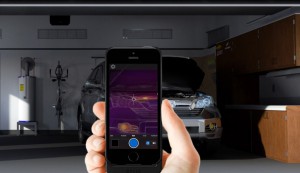The smartphone case industry is beginning to move away from bling-encrusted cheap tat and into the realms of ‘useful accessory’.
The device works by combining the heat signature information it gets from the infrared camera with the live camera image from the iPhone. This then delivers a composite thermal heat image. The result is a negative-type image of the various heat levels in an array of different colours – bright red and white being hottest.
What is it used for? It will be useful for pinpointing the position of pipes in walls, finding weak spots in your home’s insulation, finding hidden animals in bushes and identifying leaks before they cause serious damage.
Users will be able to take time lapse and panoramic thermal images, whilst being able to edit and share what they’ve captured. The case has its own battery pack, which holds a two hour charge, and weighs about the same as the phone.
Rise of the smart-case
Smart cases are in vogue. Sure, there’s still the odd 24-carat gold case floating around, but there’s also a new trend in high-tech case accessories.
The team at Vysk Communications have developed a phone case that, according to its inventor Victor Cocchia, makes your iPhone “unhackable”. Called the QS1, the $230 case has its own circuitry, its own battery pack, microphone and shutters that physically block the front and rear facing cameras.
The idea is that your calls and texts can’t be monitored because the encryption happens outside the phone, and not on the “compromised” software installed on the phone.
“The encryption is happening on the hardware chip. The communication then goes through the phone, so this way there’s no way for someone who’s got control of the phone to hear what you’re saying,” he says.
“And then we decided just in case any of those were compromised, we would put a mechanical device on the phone that physically jams the microphones.”
Security experts haven’t been able to point out a flaw in the QS1, yet. But doubts have been raised about the lack of open source code. Egemen Tas, vice president of engineering at security specialist Comodo, told me: “In order to gain the confidence of private, anonymous or sensitive users and have a wide spread adoption, they should make their core technologies open source and open to an independent audit.”
This article comes from forbes edit released
